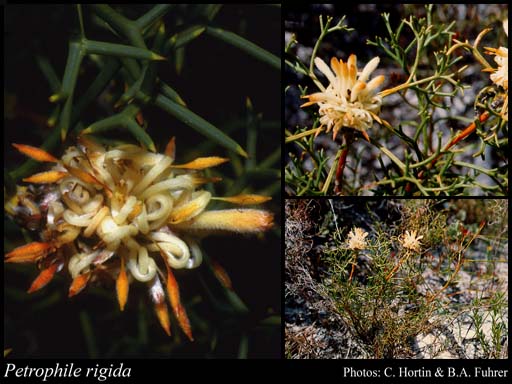- Reference
- Trans.Linn.Soc.London 10:69 (1810)
- Conservation Code
- Not threatened
- Naturalised Status
- Native to Western Australia
- Name Status
- Current
Divaricate shrub, 0.3-1.5 m high. Fl. yellow-cream, Jun or Sep to Oct. White, grey or yellow sand.

Scientific Description
Shrubs, 0.5-1.5 m high; branchlets glabrous. Leaves alternate, 25-60 mm long, glabrous; lamina terete, twice or more divided, pinnately divided, divided to the midrib, with (8-)16-18(-26) points or lobes; distance from base of leaf to lowest lobe 15-25 mm. Inflorescences not viscid, white, cream or yellow. Perianth 11-14 mm long, hairy, the limb apex hairy all over; pistil 12-15 mm long; pollen presenter fusiform, hairy, 3.5-4.5 mm long. Cone with persistent scales, 20-30 mm long. Flowers in June, September or October. Occurs in the South-west (SW) Botanical Province(s), in the Geraldton Sandplains (GS), Swan Coastal Plain (SWA), Avon Wheatbelt (AW), Jarrah Forest (JF), Mallee (MAL), Warren (WAR) or Esperance Plains (ESP) IBRA subregion(s).
Distribution
- IBRA Regions
- Avon Wheatbelt, Esperance Plains, Geraldton Sandplains, Jarrah Forest, Mallee, Swan Coastal Plain, Warren.
- IBRA Subregions
- Dandaragan Plateau, Fitzgerald, Katanning, Lesueur Sandplain, Northern Jarrah Forest, Perth, Southern Jarrah Forest, Warren, Western Mallee.
- IMCRA Regions
- WA South Coast.
- Local Government Areas (LGAs)
- Albany, Beverley, Brookton, Broomehill-Tambellup, Coorow, Cranbrook, Dandaragan, Denmark, Gingin, Jerramungup, Kalamunda, Kent, Kojonup, Kulin, Manjimup, Narrogin, Pingelly, Plantagenet, Wagin, Wanneroo, West Arthur, York.